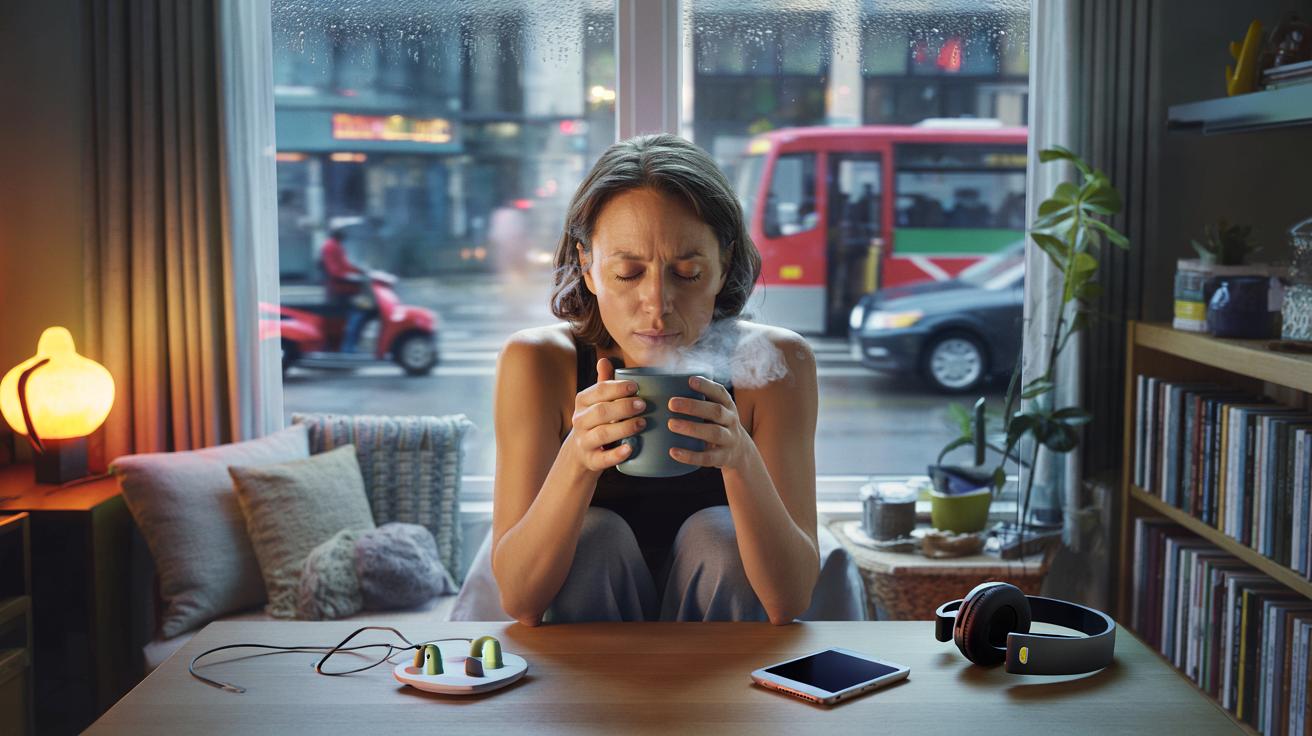Noise is the wallpaper of modern life. It’s there when you wake, when you work, when you try to fall asleep. Most of it is harmless in isolation, yet together it becomes something else: a steady press on your nervous system, a kind of invisible weather. You don’t notice how tense your shoulders are until a door slams. You don’t realise how shallow your breathing has become until the room goes quiet. This is the hidden risk of everyday noise — not the single blast, but the drip, drip, drip of sound stress.
The bus sighed past my window at 6:41 a.m., tyres whispering on wet tarmac. Someone upstairs dropped a spoon and laughed, a kettle clicked on, a phone vibrated somewhere with that needy bee-hum. I watched the steam rise and felt my heart drumming harder than the moment deserved. A scooter buzzed the lights. The fridge hummed like a thought I couldn’t put down. It wasn’t loud, not exactly. But it stacked. We’ve all had that moment when the small sounds add up to a big feeling. Then the kettle screamed.
The quiet crisis in our ears
Ordinary noise doesn’t feel like danger, yet your body doesn’t ask nicely. It reacts. The rustle of traffic, the ping of a message, the neighbour’s subwoofer at lunchtime — these layers prime the stress system to stay on. Muscles clench, cortisol nudges higher, attention frays by noon. You reach for coffee and headphones and call it coping. Noise doesn’t only live in your ears; it lives in your nervous system. It’s not dramatic. It’s cumulative. A background bias toward alertness that steals bandwidth you thought you still had.
Ask Maria, who works from a flat by the ring road. Her smartwatch shows a higher resting heart rate on weekdays and better sleep on the few nights traffic is lighter. That tracks with public-health data: long-term environmental noise has been tied to higher risks of heart disease and anxiety, especially when night-time noise breaks slumber. A normal conversation sits around 60 dB. A vacuum cleaner lives near 70 dB. A blender can spike to 90 dB. Because decibels are logarithmic, a 10 dB jump roughly feels twice as loud. Small shifts matter. So do the hours.
Here’s what’s really going on. Your brain is a prediction machine. Sounds that are unpredictable or that you can’t control keep it scanning for what’s next. That scanning has a cost. It soaks up attention, feeds a low simmer of fight-or-flight, and heightens pain and irritability. Stress loves company, so fatigue and noise egg each other on. Open-plan offices, busy streets, the endless digital chorus — each adds a few points of strain. Headphones help, but they can also mask the issue if you simply add more sound on top of sound. Quiet isn’t silence. It’s certainty.
What actually helps, today
Think of a sound diet. You need some, you want some, and you benefit from choosing what, when, and how much. Start with three levers: intensity, duration, and meaning. Lower intensity at the source: shut doors softly, put felt pads under chair legs, add a rug. Trim duration by creating a few “quiet slots” — 10 minutes without audio before your first caffeine, 5 minutes after lunch to breathe with longer exhales, one hour device-free before bed. Change the meaning by labelling a noise (“that’s the 7:10 bus, it passes”) which can dial down the body’s threat meter.
Common traps are understandable. Cranking white noise too loud to drown a busy street, wearing earplugs all day until normal sounds feel jarring, or blasting music to concentrate. Instead, keep white or brown noise low, just below speech level, and use it like a dimmer, not a wall. Alternate earplugs with “open” time to keep your system flexible. Use noise-cancelling on trains, then flip to ambient mode when walking. Set “sound boundaries” at home: music on speakers between set hours, headphones afterward. Let’s be honest: nobody does that every day. Try it most days and you’ll still feel the shift.
There’s also the gentler layer: how your body receives sound. Slow breathing with longer exhales signals safety. So does warmth, literally a cup of tea cupped in both hands. A short body scan can reduce the “noise of noise” by quieting the brain’s alarm. It’s like a fingertip to the temple. You’re not trying to win silence. You’re trying to turn down the “threat” knob while the world keeps moving.
Quiet is not the absence of sound, it’s the presence of safety.
- Reduce at source: soft close, soft surfaces, soft voices.
- Increase distance: move the speaker, move your chair, close a door.
- Add absorption: curtains, rugs, bookshelves break up echo.
- Manage timing: create daily quiet slots like meetings with yourself.
- Reset your body: longer exhale breathing, stretch, step outside.
- Protect kindly: use earplugs and ANC in bursts, not all day.
A gentler way to hear the world
There’s a reason a quiet library feels medicinal and a Sunday morning city can feel like a hug. When sound gets predictable and soft, your nervous system stands down and gives you back your focus. You can’t change the traffic or teach next door to levitate. You can change the way your day handles sound, the way your space absorbs it, the way your body interprets it. It’s small, almost boring, which is why it works. Tidy one corner of your soundscape and the rest starts to follow. Share a quiet coffee. Walk without earbuds. Leave one window for birdsong.
| Key points | Details | Interest for reader |
|---|---|---|
| Everyday noise acts like a micro-stressor | Unpredictable, uncontrollable sounds keep the brain on alert, raising stress load and draining focus over time | Explains why you feel tired, edgy, or unfocused even on “quiet” days |
| Small changes compound into relief | Lower intensity, shorten duration, and shift meaning with simple tweaks at home and work | Quick wins you can try today without buying fancy gear |
| Protect ears without overprotecting | Use earplugs and noise-cancelling in bursts, keep white noise low, mix in true quiet time | Stay comfortable now and resilient later, avoiding sensitivity rebound |
FAQ :
- What counts as “too loud” at home?Conversation is roughly 60 dB. If you need to raise your voice to speak at arm’s length, it’s likely above 70 dB and worth reducing.
- Can everyday noise really make me ill?Long-term exposure has been linked to higher stress, poor sleep, and increased cardiovascular risk. The mix of loudness, duration, and timing matters.
- Is white noise safe for sleep?Keep it low, steady, and simple. Aim just below speech level and avoid harsh, high-pitched hiss. Brown or pink noise can feel softer.
- Are noise-cancelling headphones okay all day?Great in bursts for travel or focus. Alternate with ambient mode or silent breaks so your ears and brain stay adaptable.
- How do I talk to a noisy neighbour without a row?Pick a calm time, describe one clear impact (“the bass carries into our bedroom at 11”), and suggest a fix (“could we keep bass lower after 10?”). Offer reciprocity.
First Appeared on
Source link













